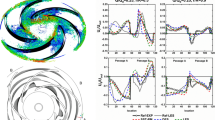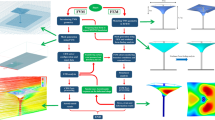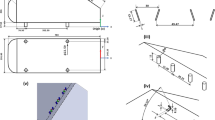Abstract
The study of hydrodynamic impact between a body in motion and a free water surface finds applications, in aeronautical fields, in splashdown and ditching problems. The effect of this impact is often prominent in the design phase of the project and, therefore, the importance of studying the event with more accuracy than in the past is imperative. Usually the study of the phenomenon is dealt with experiments, empirical laws, and lately, with finite element simulations. These simulations are performed by means of special codes that allow the fluid-structure coupling; these codes have their origin in Lagrangian finite element programs developed for crash analysis improved with possibility of interfacing with Eulerian spatial description, typical of fluids. Critical points in this type of modelling are the fluid-structure interaction algorithms, constitutive modelling of the fluid and time efficiency of the computation. This study describes an effort that focuses on the development of a crash modelling and simulation approach utilizing a non-linear explicit finite-element code (LSDYNA 960) to demonstrate the potential for helicopter water impact analysis in the development of crash design criteria and concepts. Initially, the water model shall be developed and validated using default Lagrangian techniques. Subsequently, more accurate Arbitrary Lagrangian Eulerian analyses will be conducted to obtain finer results for the ball impact scenario and helicopter impact. Finally, the response of an occupant for the above helicopter crash test shall be analyzed using the MADYMO code, utilizing accelerations obtained from the LSDYNA output. Lumbar load, the most crucial mode of injury in these types of crashes will be investigated and discussed.
Similar content being viewed by others
REFERENCES
Aircraft Crash Survival Design Guide, U.S. Army AVSCOM TR 89-D-22 (Volume A-E), US Army Aviation Research and Technology Activity, Ft. Eustis, VA, 1989.
Analysis of Rotorcraft Crash Dynamics for Development of Improved Crashworthiness Design Criteria, DOT/FAA/ CT-85/11, U.S. Department of Transportation, Federal Aviation Administration, Technical Center, Atlantic City, N J, June 1985.
Ashish, K Sareen, Michael, R Smith, Emam, Hashish. “Crash Analysis of an Energy Absorbing Subfloor during Ground and Water Impacts”, Bell Helicopter Textron, Inc., Fortworth, Texas.
M'hamed, Souli. “An Eulerian and Fluid-Structure coupling algorithm in LS-DYNA”, Livermore Software Technology Corporation, California.
Bathe, K J. “Finite Element Procedures in engineering analysis”, Prentice Hall 1997.
John, O Hallquist. “Simplified Arbitrary Lagrangian-Eulerian”, LS-DYNA Theoretical Manual, May 98.
Jean, Luc LACOME. “Smooth Particle Hydrodynamics (SPH): A new feature in LS-DYNA, DYNALIS.
John, O Hallquist, “Material Models”, LS-DYNA User Manual, Ver. 950, May 1999.
Victor, L Streeter, “Handbook of Fluid Dynamics”, First Edition, University of Michigan, 1961.
Penetecote, N and Kindervater, C M. “Airframe Water Impact Analysis Using a Local/Global Methodology”, German Aerospace Center (DLR), Institute of Structures and Design, D-70569, Germany.
User's Manual Model 1000HRC, Kodak Ektapro Motion Analyzer, Motion Analysis Systems, San Diego, California.
John, O Hallquist. “Belytcshko-Lin-Tsay Shell Elements”, LS-DYNA User Manual, May 1999.
John, O Hallquist. “Solid Elements”, LS-DYNA Theoretical Manual, May 1998.
MSC Patran, Ver. 2000, Theory Manual, March 2000.
MADYMO, User Manual, Version 5.4, May 1999._
Rights and permissions
About this article
Cite this article
Randhawa, H.S., Lankarani, H.M. Finite element analysis of impacts on water and its application to helicopter water landing and occupant safety. International Journal of Crashworthiness 8, 189–200 (2003). https://doi.org/10.1533/ijcr.2003.0229
Issue Date:
DOI: https://doi.org/10.1533/ijcr.2003.0229




